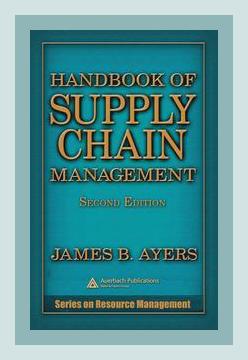Operations and Supply Chain ManagementOperations Strategy
Handbook of Supply Chain Management by James B. Ayers: A 5-Page Summary
Introduction
James B. Ayers’ “Handbook of Supply Chain Management,” published in 2000, is a comprehensive guide focused on the strategies and operational intricacies required to effectively manage supply chains. This book provides deep insights into the principles underpinning supply chain management (SCM), encompassing every aspect from design to implementation, while offering actionable advice for professionals in the field. This summary will break down the book into key areas of focus, highlighting major points along with concrete examples and specific actions that readers can implement.
Chapter 1: Understanding Supply Chain Management
Key Points:
– Definition and Scope: SCM involves coordination of all processes involved in producing and delivering a product from raw materials to the end customer.
– Objectives: Increase efficiency, reduce costs, improve customer service, and enhance the overall value chain.
– Components: Suppliers, manufacturers, warehouses, transporters, retailers, and customers.
Concrete Examples:
– Dell Computers: Utilizes a build-to-order model where components are sourced from around the world and assembled only after an order is placed, reducing inventory costs and ensuring up-to-date technology.
Actionable Step:
– Map Your Supply Chain: Identify all players involved, from suppliers to end customers. Understanding the complete flow can help in pinpointing inefficiencies and opportunities for improvement.
Chapter 2: Designing the Supply Chain
Key Points:
– Strategy Development: Align supply chain strategy with the business strategy. A responsive supply chain is critical for fast-moving industries, whereas a cost-effective supply chain is more suitable for stable markets.
– Network Design: Deciding on the number and location of production facilities and warehouses.
Concrete Examples:
– Toyota Production System: Employs a just-in-time production model to reduce waste and improve efficiency, aligning operational activities directly with market demand.
Actionable Step:
– Conduct a SWOT Analysis: Analyze the strengths, weaknesses, opportunities, and threats related to your current supply chain. Use the outcomes to refine your supply chain design to better align with your strategic goals.
Chapter 3: Supply Chain Optimization
Key Points:
– Use of Technology: Advanced planning systems (APS), ERP systems, and other technologies can optimize supply chain operations.
– Inventory Management: Implementing Just-In-Time (JIT), Vendor Managed Inventory (VMI), and other strategies to maintain optimal inventory levels.
Concrete Examples:
– Walmart’s Inventory Management System: Leverages an advanced inventory management system allowing for seamless coordination with suppliers and efficient stock replenishment based on real-time data.
Actionable Step:
– Invest in Technology: Identify and implement technology solutions that can help streamline your supply chain processes. For instance, an ERP system can integrate various supply chain activities and provide real-time data, improving decision-making.
Chapter 4: Supply Chain Integration
Key Points:
– Coordination and Collaboration: Achieving smooth coordination across the supply chain including suppliers, manufacturers, and distributors.
– Information Sharing: Transparent and real-time sharing of information helps in better demand forecasting and collaborative planning.
Concrete Examples:
– Procter & Gamble and Wal-Mart: Their collaborative planning, forecasting, and replenishment (CPFR) approach has resulted in significant cost reductions and improved inventory management.
Actionable Step:
– Enhance Communication Channels: Establish robust and transparent communication channels and protocols with key supply chain partners to improve coordination and collaboration.
Chapter 5: Managing Supply Chain Risks
Key Points:
– Risk Identification: Recognize potential risks including supplier reliability, political instability, natural disasters, and market fluctuations.
– Mitigation Strategies: Develop contingency plans, diversify suppliers, and invest in risk management tools.
Concrete Examples:
– Honda’s Risk Management: After the 2011 earthquake in Japan, Honda diversified its supplier base and reviewed supply chain vulnerabilities, leading to a more resilient operation.
Actionable Step:
– Develop a Risk Management Plan: Identify potential risks in your supply chain and develop a comprehensive plan that includes mitigation strategies and contingency preparations.
Chapter 6: Performance Measurement
Key Points:
– Key Performance Indicators (KPIs): Identify critical KPIs such as delivery performance, order accuracy, and lead time.
– Continuous Improvement: Implement systems for continuous monitoring and improvement of supply chain performance.
Concrete Examples:
– Balanced Scorecard Approach: Used by many corporations to align business activities with the vision and strategy of the organization, improve internal and external communications, and monitor organization performance.
Actionable Step:
– Establish KPIs: Define clear, measurable KPIs to regularly assess the performance of your supply chain. Use these metrics to identify areas for improvement and to track progress over time.
Chapter 7: Sustainable Supply Chain Management
Key Points:
– Environmental and Social Considerations: Incorporate sustainability into supply chain practices, considering both environmental impacts and social responsibilities.
– Ethical Sourcing: Engage in fair trade practices and ensure supplier adherence to ethical standards.
Concrete Examples:
– Starbucks’ Ethical Sourcing: Through its Coffee and Farmer Equity (C.A.F.E.) Practices, Starbucks ensures ethically sourced coffee, promoting social and environmental best practices.
Actionable Step:
– Implement Sustainable Practices: Establish sustainability goals and work with suppliers to ensure environmentally friendly materials and socially responsible labor practices are used throughout the supply chain.
Chapter 8: Future Trends in Supply Chain Management
Key Points:
– Technology Impact: Future SCM will increasingly rely on technologies such as AI, IoT, blockchain, and big data analytics for more efficient operations.
– Evolving Consumer Preferences: Supply chains need to be adaptable to changes in consumer behavior and preferences.
Concrete Examples:
– Amazon’s Use of Robotics: Amazon’s warehouses employ advanced robotics systems to enhance speed and accuracy in order fulfillment.
Actionable Step:
– Stay Informed on Emerging Technologies: Continuously research and adopt emerging technologies that have the potential to transform and optimize your supply chain.
Conclusion:
In “Handbook of Supply Chain Management,” James B. Ayers provides a thorough and practical guide to understanding, designing, optimizing, integrating, and managing supply chains. By implementing the actionable steps highlighted alongside each major point, professionals can build and maintain robust, efficient, and responsive supply chains capable of meeting today’s dynamic business and consumer demands.
